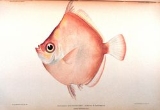
Caproidae
Encyclopedia
Boarfishes are a small family, Caproidae, of marine fish
es comprising two genera and twelve species. They are usually placed in the order Zeiformes
with the dories
, but this placement is uncertain, since boarfishes have many perciform
characters, for instance in the caudal skeleton. Boarfishes are native to the Indian
, Atlantic
, and Pacific Ocean
s, where mainly found at depths below 50 metres (164 ft).
Like other zeiform fishes, boarfishes have deep and thin bodies. Boarfishes are small, with only a few species known to reach a maximum total length of 30 centimetres (11.8 in). Coloration is red, pink and silvery.
The earliest identified caproid fossil
s date to the middle Oligocene
epoch of the middle Tertiary
period, or roughly 20 to 30 million years ago.
Fish
Fish are a paraphyletic group of organisms that consist of all gill-bearing aquatic vertebrate animals that lack limbs with digits. Included in this definition are the living hagfish, lampreys, and cartilaginous and bony fish, as well as various extinct related groups...
es comprising two genera and twelve species. They are usually placed in the order Zeiformes
Zeiformes
The Zeiformes are a small order of marine ray-finned fishes most notable for the dories, a group of common food fish. The order consists of about 40 species in seven families, mostly deep-sea types....
with the dories
Zeidae
The Zeidae are a family of large, showy, deep-bodied zeiform marine fish—the "true dories". Found in the Atlantic, Indian, and Pacific Ocean, the family contains just six species in two genera...
, but this placement is uncertain, since boarfishes have many perciform
Perciformes
The Perciformes, also called the Percomorphi or Acanthopteri, is one of the largest orders of vertebrates, containing about 40% of all bony fish. Perciformes means perch-like. They belong to the class of ray-finned fish and comprise over 7,000 species found in almost all aquatic environments...
characters, for instance in the caudal skeleton. Boarfishes are native to the Indian
Indian Ocean
The Indian Ocean is the third largest of the world's oceanic divisions, covering approximately 20% of the water on the Earth's surface. It is bounded on the north by the Indian Subcontinent and Arabian Peninsula ; on the west by eastern Africa; on the east by Indochina, the Sunda Islands, and...
, Atlantic
Atlantic Ocean
The Atlantic Ocean is the second-largest of the world's oceanic divisions. With a total area of about , it covers approximately 20% of the Earth's surface and about 26% of its water surface area...
, and Pacific Ocean
Pacific Ocean
The Pacific Ocean is the largest of the Earth's oceanic divisions. It extends from the Arctic in the north to the Southern Ocean in the south, bounded by Asia and Australia in the west, and the Americas in the east.At 165.2 million square kilometres in area, this largest division of the World...
s, where mainly found at depths below 50 metres (164 ft).
Like other zeiform fishes, boarfishes have deep and thin bodies. Boarfishes are small, with only a few species known to reach a maximum total length of 30 centimetres (11.8 in). Coloration is red, pink and silvery.
The earliest identified caproid fossil
Fossil
Fossils are the preserved remains or traces of animals , plants, and other organisms from the remote past...
s date to the middle Oligocene
Oligocene
The Oligocene is a geologic epoch of the Paleogene Period and extends from about 34 million to 23 million years before the present . As with other older geologic periods, the rock beds that define the period are well identified but the exact dates of the start and end of the period are slightly...
epoch of the middle Tertiary
Tertiary
The Tertiary is a deprecated term for a geologic period 65 million to 2.6 million years ago. The Tertiary covered the time span between the superseded Secondary period and the Quaternary...
period, or roughly 20 to 30 million years ago.
Species
- Genus AntigoniaAntigonia (fish genus)Antigonia is a genus of zeiform marine fish belonging to the family Caproidae, of which it composes eleven of the family's twelve species. Antigonia carry the common name boarfish. These are deep-water species, generally found at depths below ....
- Antigonia aurorosea Parin & Borodulina, 1986.
- Deepbody boarfish, Antigonia caprosAntigonia caprosAntigonia capros is a species of fish in the Caproidae family. It is the most widespread species in the family, found at depths of in the Atlantic, Indian and Pacific Oceans.-References:...
Lowe, 1843. - Shortspine boarfish, Antigonia combatia Berry & Rathjen, 1959.
- Antigonia eos Gilbert, 1905.
- Antigonia indica Parin & Borodulina, 1986.
- Antigonia malayana Weber, 1913.
- Rhomboidal boarfish, Antigonia rhomboidea McCulloch, 1915.
- Indo-Pacific boarfish, Antigonia rubescens (Günther, 1860).
- Antigonia rubicunda OgilbyWilliam OgilbyWilliam Ogilby was an Irish barrister and naturalist.Ogilby was honorary secretary of the Zoological Society of London from 1839 to 1846....
, 1910. - Antigonia saya Parin & Borodulina, 1986.
- Antigonia xenolepis Parin & Borodulina, 1986.
- Genus Capros
- Capros aper (LinnaeusCarolus LinnaeusCarl Linnaeus , also known after his ennoblement as , was a Swedish botanist, physician, and zoologist, who laid the foundations for the modern scheme of binomial nomenclature. He is known as the father of modern taxonomy, and is also considered one of the fathers of modern ecology...
, 1758).
- Capros aper (Linnaeus
See also
- Some fish of the family Pentacerotidae family (order PerciformesPerciformesThe Perciformes, also called the Percomorphi or Acanthopteri, is one of the largest orders of vertebrates, containing about 40% of all bony fish. Perciformes means perch-like. They belong to the class of ray-finned fish and comprise over 7,000 species found in almost all aquatic environments...
) are also called boarfish.

